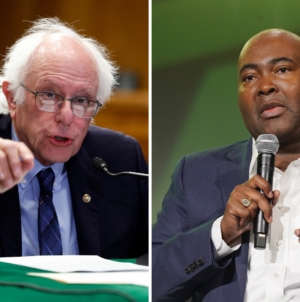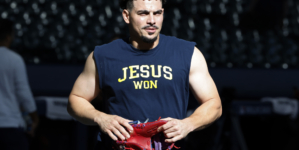-
DNC Chair Rips Bernie Sanders’ Election Comment: ‘Straight Up BS’ - 9 mins ago
-
L.A. County increases reward to $25,000 for info in decades-old death - 23 mins ago
-
Liam Payne’s Death: What We Know as 3 Are Accused of Crimes in Argentina - 27 mins ago
-
Bet365 Bonus Code WEEK365: Get $150 Bonus or $1K Bet for Bengals-Ravens TNF - 44 mins ago
-
Column: Harris’ defeat opens a bumpy path to the White House for Newsom - about 1 hour ago
-
Trump’s Tax Proposals Face a Fiscal Reckoning - about 1 hour ago
-
Dodgers, Mets Have Made Offers to Free Agent Shortstop Willy Adames: Report - about 1 hour ago
-
Two people fatally shot in Mount Washington - 2 hours ago
-
Defeating Florida’s Abortion Referendum Was a Win for Women | Opinion - 2 hours ago
-
Transgender Americans Voice New Anxiety About Trump Agenda - 2 hours ago
Working Class Voters Aren’t Who the Media Thinks They Are | Opinion
Every four years, I watch political reporters flock to the same stereotypical diners in search of the “working man’s opinion.” And then I watch them turn the opinions of a few white men into a sweeping generalization about union members and labor voters. It’s a ritual that is shortsighted, tone-deaf, and flat-out insulting. Not to mention—they just get it wrong.
Recent hysterical headlines would have you believe that union members are all white men in hard hats and work boots aligned behind former President Donald Trump. But the reality is that union members—who consistently vote at levels above the general population—and the wider working class are also Black, Latina, and Asian Pacific Islander women who make up the majority of our care workforce. They’re the millions of men and women, of all races, who are largely invisible no matter where we are in the political cycle. They contribute to our economy in countless ways and they don’t all think or look alike.
These diverse working Americans aren’t sitting around in diners because, well, they’re working. They are heading to their second or third jobs, taking their kids to daycare that’s nearly unaffordable, checking in on elderly parents who need care and companionship. They’re waiting at the bus stop in the rain, they’re volunteering in their communities, they’re attending union meetings. They’re busy. And they’re tired of being overlooked.

Jeff Swensen/Getty Images
To ensure the voices of all voters are heard in this election, our union committed $200 million to mobilize working-class voters of all races, men and women alike. Pundits will tell you these folks are “low-propensity,” “disaffected,” or “unlikely,” to vote. And of course, the MAGA candidates who claim to speak for these folks don’t really want them to vote at all. But we see them as “high-opportunity” because they represent a great, untapped electorate that has been discounted and silenced by the media and campaigns for too long.
The key to reaching these high-opportunity voters is to listen to them. They are our family members, our neighbors, and our friends. They care about healthcare and reproductive rights, climate change and racial justice, immigration and LGBTQ rights, wages and working standards. They want corporations to stop price gouging, quit union-busting, and pay a fair wage. They want elected leaders to make it easier for workers to join a union. And they want a better future for their kids and grandkids—one that is safe, healthy, and hopeful.
Hope comes up all the time in our conversations with voters and is central to our seven-figure digital and TV ad campaign, “The Workers’ Election.” We’re running ads in key battlegrounds in seven languages, including Spanish, Vietnamese, and Tagalog. Eighty-seven percent of our political spending is in communities of color. “It’s Ok To Hope Again,” is a reflection of real conversations we’re having with voters. Working class voters who are not aligned behind Trump.
As research from the Working Families Party shows, the majority of working-class voters support progressive economic policies and reject the divisive, racist, and false narratives being spun by MAGA candidates. By the way, there are plenty of white men who are members of the Service Employees International Union and see plainly that Trump is anti-worker and a danger to our democracy.
Our multiracial team of member political organizers has reached more than 6 million voters. Door-knocking across the country, we share how Harris and Walz have a plan to build an opportunity economy that will make it easier to join unions and earn a living wage, own your own home, pay for groceries and prescriptions, and even send your kids to college. The more working-class voters hear about these plans, the more their support grows.
Vice President Kamala Harris walks the walk, as far as these high-opportunity voters are concerned. She joined picket lines with striking fast food workers and walked a day in the shoes of an Alameda home care worker and Detroit security officer to understand their struggles. As vice president, she proposed the biggest investment in care work ever, taking on Big Pharma to lower prescription drug costs for seniors, and creating millions of good union jobs.
Meanwhile, Trump says he’ll fire striking workers and gut public unions. He handed out tax breaks to corporations and billionaires, tried to take healthcare coverage from millions of Americans, and appointed Supreme Court justices who made it harder to join unions and took away our reproductive freedoms.
Working-class voters—all of them, not just the white men—will decide this election, and I believe they will vote for the leaders who have had their backs, not those who seek to further enrich themselves and greedy corporations.
April D. Verrett is president of the Service Employees International Union (SEIU), which represents nearly 2 million members across the service and care industries in the U.S. and Canada. She was elected in May 2024, becoming the union’s first Black woman president.
The views expressed in this article are the writer’s own.
Source link















